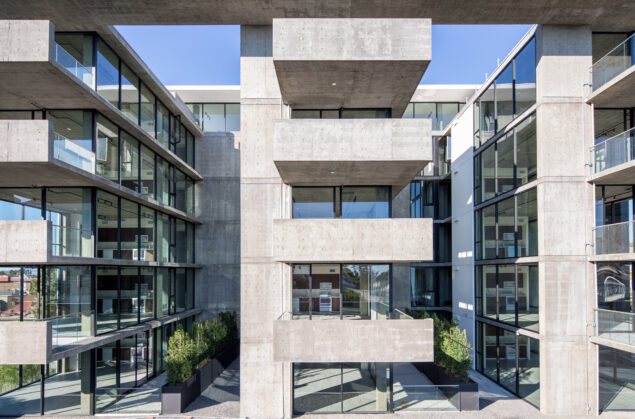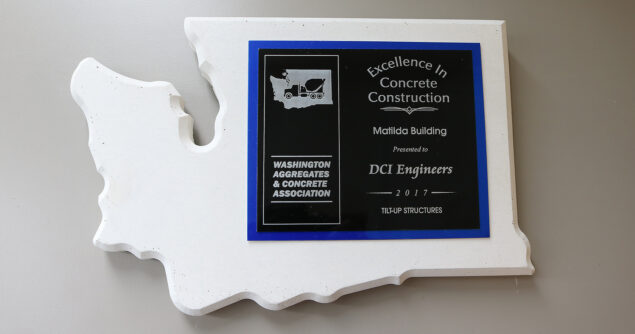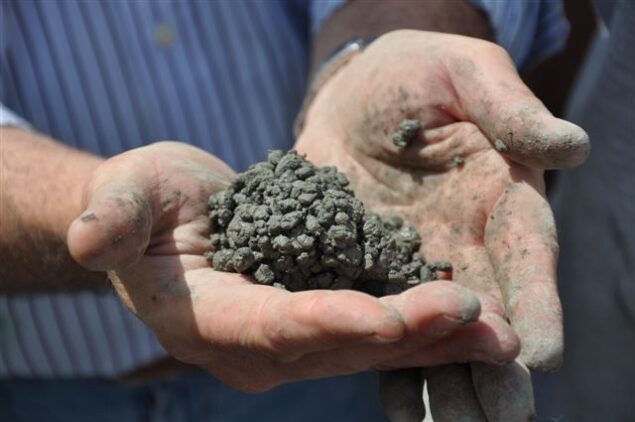This post is the second of a two-part series focusing on the future of concrete practices and innovation in the architecture/engineering/construction (AEC) industries. The topics featured here are common discussions raised by DCI’s in-house concrete technical committee to further understand the latest technology and trends associated with structural concrete design. Partnering with our concrete subcontractors, suppliers, and general contractors, DCI has explored new ways of providing efficient design that result in more floor-to-ceiling height, open floor layouts, lighter, and more importantly – low carbon concrete structural systems.
This year, DCI committed to the SE2050 Challenge issued by the Carbon Leadership Forum (CLF) and Structural Engineering Institute (SEI), an industry-wide initiative driving toward carbon-neutral structures by the year 2050. Additionally, new state and local regulations adopted across the country (e.g., Buy Clean California Act, Marin County Low Carbon Concrete Code, City of Portland Low-Carbon Concrete Purchasing Program, and pending federal regulations [CLEAN Future Act]) now require product-specific environmental product declarations (EPDs) and set global warming potential (GWP) thresholds for building materials associated with public-funded projects.
The DCI sustainability team continues to enhance our structural design practices to meet and go above these regulations. This year the group has made an investment in updating the firm’s specifications and general notes to promote reduced-impact building material for all material types, including low-carbon concrete, in addition to performing structural life cycle assessments (LCAs) and further developing in-house knowledge of best practices related to sustainability and structures. Where our team is seeing the most questions and concern around carbon reduction has been in the use of concrete as a primary building material, so we wanted to share some of our knowledge on a few of the best reduction methods we are implementing.
Foreseeing the potential of carbon pricing for future buildings, our in-house sustainability committee is making embodied carbon a key consideration in DCI projects, particularly when it comes to concrete. To meet this challenge, the committee is evaluating the firm’s existing structural design practices and updating drawing specifications which promote reduced-impact building material, such as low-carbon concrete. In the past two years, the sustainability committee has been very active in the effort. Among their accomplishments, the group has updated the firm’s concrete general notes; began performing life-cycle assessments and EPD tracking; and grown in-house knowledge of best practices related to sustainability and structures. The committee will be continuing these efforts in the upcoming year. They are working to educate clients and project teams about the benefits of embodied carbon reduction.
“Concrete has the most flexibility for environmental impact reduction because of the variety of ingredients and production methods that can be utilized to achieve strength, durability, and sustainability goals,” said Jessica Martinez, who co-chairs DCI’s in-house sustainability committee.

Jessica coordinates concrete specifications with design and construction teams which allow suppliers to develop efficient, low-carbon concrete mixtures. We do this by allowing higher quantities of cement replacement, encouraging the use of blended cements and admixtures, tailoring concrete specifications to include performance-focused requirements, and much more.
The sustainability committee team works with project managers on how to promote the use (and availability) of low carbon concrete mix with our contracting partners. If coordinated early in the construction bidding process, the design team can require GWP limits and EPDs. These essentially act as a “nutrition label” for the environmental impacts associated with the material to measure the carbon footprint associated with structure and promote the production of low-carbon building materials. This gives GCs the time to compare concrete suppliers, produce a cost analysis and coordinate what is feasible for the project’s sustainability goals.
“When considering impacts associated with the transportation and procurement of raw materials, the most cost-effective mixture is oftentimes the most environmentally friendly,” Jessica said.
“If we drive change in the industry this way, suppliers will see building designers are seeking increasingly higher environmental impact reductions and work harder to compete within the market to promote more sustainable, competitive products – which is a great strategy to support our commitment to the SE 2050 challenge,” she said.
DCI’s sustainability expertise is best utilized when the engineering team is involved early in the design process. This allows the group to advise on the most efficient structural system and also look for opportunities to reduce environmental impacts associated with a project, by providing system and material comparisons that consider whole-building GWPs. For clients looking for more extensive environmental impact reductions, DCI can implement additional services to conduct LCAs and embodied carbon tracking at designated stages throughout the design process. During the construction of the building, we can help to coordinate material options with the design consultants and general contractor to consider environmental impact as a factor in procurement decisions.
“If we are involved earlier in the project, we have the opportunity to weigh in on the building concept before it’s finalized so we can consider the structural system and materials which can play a part in maximizing environmental impact reductions,” Jessica said. “Then throughout the design process, we can analyze the environmental impact associated with the incorporation of major structural changes, such as the addition of sloping columns or a transfer beams. We can take a look at the effect these changes have on the project and provide this as another factor to help the team determine their decisions in regard to sustainability.”
One important factor to consider with achieving sustainability success is focusing on quality control. For large concrete projects, the DCI sustainability committee evaluates the concrete mix design tables to tweak specifications for additional environmental impact reductions, and when possible, they dive deeper into coordinating EPD and GWP requirements. For example, the team may find an outdated reference on a drawing which calls for 3,000 psi concrete with a 0.45 water-to-cement ratio and no associated exposure category, but with that ratio, you may get up to 5,000 psi concrete - more strength and cement content than needed for the application.
“It’s common to have those outdated references on drawings – it happens across the industry, it’s not just us,” she said. “Oftentimes, engineers in the building industry retain prescriptive requirements included in concrete specification templates because this is how our predecessors were taught. Without realizing it, designers may be following outdated code references and specifications because it’s baked into their practice, although material production and construction methods have changed immensely over the years. DCI’s sustainability team works to stay up-to-speed with the latest industry and code innovations, so we can continue moving towards more performance-based specifications and yield more efficient concrete mixtures.”
For a current concrete office building Jessica is currently managing in Austin, Texas, she was able to reduce the global warming potential by 8 to 10% when compared to industry baselines, simply by updating the project’s concrete specifications before submitting for the bidding process.
The biggest tip for carbon concrete reduction: involve an engineering team early in the design process to capture the maximum amount of environmental impact reductions possible. DCI’s sustainability services range from comparing the GWP associated with structural systems to implementing more in-depth structural LCAs and everything in between! When it comes to cementitious material, DCI is ready and prepared to track EPD requirements, and specify material with targeted GWP limits. For more key considerations on low carbon concrete design, download DCI’s information sheet below.
Rose Bechtold, Communications Specialist | Rose comes from a journalism and technical writing background. She is in her element while in research mode and naturally immerses herself in expert knowledge by interviewing staff members about new subjects. In her spare time, Rose practices plein-air sketching of buildings and random scenes around town.




